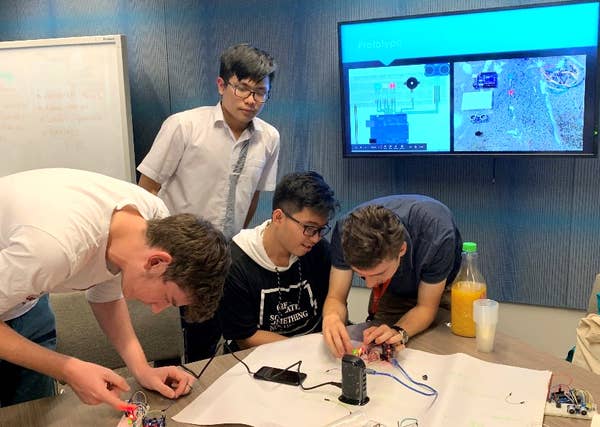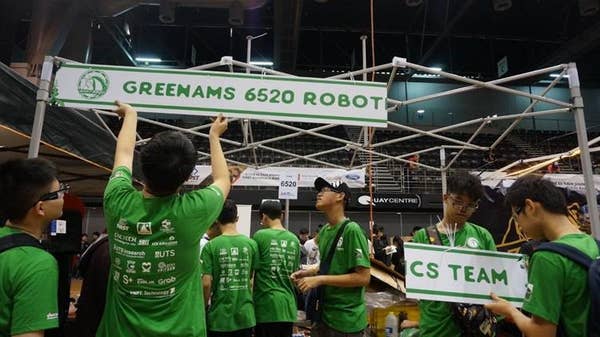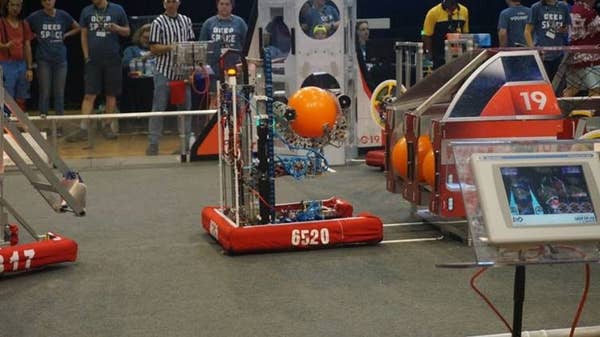It’s easy to see the fascination for mechatronics - which combines electronics, mechanical, computer systems and software engineering - shared by a group of 28 exceptional high school students during a recent visit to UTS’s Faculty of Engineering and IT.
Visiting Australia from Vietnam as part of an international robotics competition, the group took time out to tour UTS’s state-of-the-art 3D printing facilities and visit its Centre for Autonomous Systems - an internationally-acclaimed robotics research group aiming to create positive change for government, industry and the wider community.
During the tour, students undertook hands-on exercises to experience UTS’s practical approach to learning. In less than 40 minutes, the Years 10-12 students, from the Amsterdam High School for the Gifted in Hanoi, enthusiastically completed a design-thinking challenge, creating prototypes of a device that gives visual feedback on distance.
The circuit system, constructed with wiring and lights, could be applied to a wide range of industries, including transport and infrastructure, or for commercial use such as in robotic toys. Yet the students’ ideas were aimed at helping society - one to detect landmines and prevent explosions, and another to monitor the height of trees and report data on growth.

Constructing visual sensors to monitor distance with the UTS Robotics Club.
Student Tran Anh Quan explained what underpinned their interest, and his desire to pursue a career in mechatronics in the clean energy industry. “It’s our responsibility to care about the planet,” he said.
Many career options ahead
Jacob Vartanian, former president of the UTS Robotics Society, and two Robotics Society volunteers, conducted the hands-on class with the high school students. “The groups went very well,” he reported. “It was good to see rapid innovation being taken on - they were able to quickly come up with solutions to various problems. We saw that while everyone had the same product to build a solution around, there were four unique areas explored.”
Jacob also highlighted the range of possibilities open to these students if they continue their interest and studies in mechatronics. “Careers these students might be interested in could involve innovation, product design and development, and rapid prototype in engineering and design,” he said.
Encouraging Vietnamese youth in STEM is key for the country’s economic growth. “With Industry 4.0 a major driver of innovation, technology development and automation in Vietnam, the opportunities open to these talented students are exciting,” said Kate Dennis, Head of Corporate Communication for UTS Insearch, the pathway to UTS. “Their desire to use their knowledge and skills, and future careers, to improve society is inspiring.”
Supporting the team for the FIRST Robotics Competition
UTS and UTS Insearch co-sponsor the GreenAms 6520 team from Amsterdam High School for the Gifted in Vietnam, supporting them to attend the FIRST (For Inspiration and Recognition of Science and Technology) Robotics Competition in Sydney. Forty teams from different schools around the region competed in Sydney in March 2019, with the top teams going on to the next stage of the FIRST Robotics Competition in the US later in the year.
To compete, students design, build, program and drive robots - which can weigh up to 50 kgs - to finish a series of tasks and compete against others. Students learn a range of skills in engineering across several disciplines; shaping metal, designing electronics, programming controls systems and creating complex autonomous programs to control their robot.

GreenAMS team prepares for the FIRST Robotics Competition in Sydney.

GREENAMS 6520’s robot.